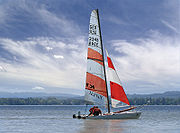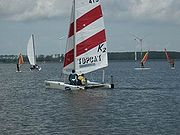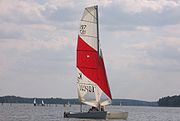
Topcat
Encyclopedia




One-design
One-Design is a racing method where all vehicles or boats have identical or very similar designs or models. It is also known as Spec series. It is heavily used in sailboat racing. All competitors in a race are then judged based on a single start time...
sailing catamaran
Catamaran
A catamaran is a type of multihulled boat or ship consisting of two hulls, or vakas, joined by some structure, the most basic being a frame, formed of akas...
boat class, which is divided into several boat sizes.
General
The Topcat sailing catamarans are fast, seaworthy, popular, and affordable twin-hull boats ranging in size from 3.60 m (12 ft) to 5.50 m (18 ft). They have world-wide distribution and are differentiated by:- Production of the hulls in fiberglassFiberglassGlass fiber is a material consisting of numerous extremely fine fibers of glass.Glassmakers throughout history have experimented with glass fibers, but mass manufacture of glass fiber was only made possible with the invention of finer machine tooling...
- Hull design without daggerboardDaggerboardA daggerboard is a retractable centreboard used by various sailing craft. While other types of centreboard may pivot to retract, a daggerboard slides in a casing. The shape of the daggerboard converts the forward motion into a windward lift, countering the leeward push of the...
s - Assembly without bolts
- Transportable on a trailer (width less than 2.55 m to comply with German traffic laws)
- Transportable on the roof rack of a car
- Simplification of existing designs
History
- 1975 In the mid-70s two German A-Cat sailors, Bernd Breymann und Klaus Enzmann, were unhappy with the complicated transport and assembly of their boats. Klaus Enzmann build a first prototype without daggerboards or rudders, similar to the Spanish "Patin-Vela", but with many of the successful details of the later boats.
- 1976 The new "Kick-up" rudder was added to the prototype. The rudder and other Topcat details were registered as patents.
- 1977 The first Topcat appeared, a 4.80 m long twin-hull boat that was simply plugged together. It had a mast height of 7.00 m, a jibJibA jib is a triangular staysail set ahead of the foremast of a sailing vessel. Its tack is fixed to the bowsprit, to the bow, or to the deck between the bowsprit and the foremost mast...
sail of 3.6 m², and a mainsailMainsailA mainsail is a sail located behind the main mast of a sailing vessel.On a square rigged vessel, it is the lowest and largest sail on the main mast....
of 11.2 m².
- 1977-1979 Production of the first 60 Topcats. Capacity was limited by the rented wood shack, so the production of the hulls was moved to Italy, and company headquarters was moved to GilchingGilchingGilching is a municipality in the district of Starnberg, in Bavaria, Germany. It is situated 13 km north of Starnberg, and 22 km west of Munich . The quarters Argelsried, Neugilching and Geisenbrunn belong to the municipality of Gilching....
, Germany. In 1979 Bernd Breymann and Klaus Enzmann founded TOPCAT GmbH. Worldwide distribution of the boat was supported by onsite training.
- 1981 The first Topcat class association was established. The first Topcat bases were founded at the Lake GardaLake GardaLake Garda is the largest lake in Italy. It is located in Northern Italy, about half-way between Brescia and Verona, and between Venice and Milan. Glaciers formed this alpine region at the end of the last ice age...
.
- 1983 Creation of ITCA (International Topcat Class Association). In the same year the first European championship was held in BrenzoneBrenzoneBrenzone is a comune in the Province of Verona in the Italian region Veneto, located about 120 km west of Venice and about 35 km northwest of Verona...
, Lake GardaLake GardaLake Garda is the largest lake in Italy. It is located in Northern Italy, about half-way between Brescia and Verona, and between Venice and Milan. Glaciers formed this alpine region at the end of the last ice age...
, with 44 boats from 5 countries.
- 1985 The faster and wider 18ft dual-trapeze "Spitfire" model appeared. More volume was added to the hulls, which was much appreciated by heavier crews. Furthermore the sails were redesigned, to improve low-wind performance.
- 1993-2000 Development of the modular K-series boats, to increase speed, safety, and handling. The K1, K2, and K3 boats are approved for ITCA racing.
- 2005 The 4.5 model was released, to address the low load-carrying capacity of the entry-level model. For young sailors the Topcat Chico model was developed.
- 2005 The Topcat was recognized as an official ISAFInternational Sailing FederationThe International Sailing Federation is recognised by the International Olympic Committee as the world governing body for the sport of sailing....
racing class. The first world championship was held in September 2005 in TorboleNago-TorboleNago-Torbole is a comune in Trentino in the northern Italian region Trentino-Alto Adige/Südtirol, located about 30 km southwest of Trento on the north shore of Lake Garda...
at Lake GardaLake GardaLake Garda is the largest lake in Italy. It is located in Northern Italy, about half-way between Brescia and Verona, and between Venice and Milan. Glaciers formed this alpine region at the end of the last ice age...
.
Design

The Topcat lacks the dangerous main boom
Boom (sailing)
In sailing, a boom is a spar , along the foot of a fore and aft rigged sail, that greatly improves control of the angle and shape of the sail. The primary action of the boom is to keep the foot of the sail flatter when the sail angle is away from the centerline of the boat. The boom also serves...
, as well as daggerboards,
spreader
Spreader (sailboat)
A spreader is a spar on a sailboat used to deflect the shrouds to allow them to better support the mast. Often, there are multiples, called spreaders. The spreader or spreaders serve much the same purpose as the crosstrees and tops in a traditional sailing vessel.Spreader design and tuning can be...
s, shroud
Shroud (sailing)
On a sailboat, the shrouds are pieces of standing rigging which hold the mast up from side to side. There is frequently more than one shroud on each side of the boat....
adjusters,
and other complicated trimming mechanisms.
To compensate for the missing daggerboards, the hull profiles are narrow and deep, and form
a keel, similar to the Dart 18
Dart 18
The Dart 18 is a one-design long glassfibre sailing catamaran. It is designed to be sailed by two people and can achieve speeds of up to 20 knots.-History:...
and other beach catamarans. This is a compromise between lateral stability, agility in maneuvers, and ability to run up the beach. The material of the hulls
is fiberglass
Fiberglass
Glass fiber is a material consisting of numerous extremely fine fibers of glass.Glassmakers throughout history have experimented with glass fibers, but mass manufacture of glass fiber was only made possible with the invention of finer machine tooling...
, with a strength of a few millimeters on top and on the upper sides.
Extra material is applied in areas subject to abrasion and stress forces: at the keel, and where the beams, shrouds, and rudders connect to the hulls.
There are special boat versions with a build-up keel for sailing schools and for sailing areas with coral reefs. The surface of the hulls is covered by a gelcoat
Gelcoat
Gelcoat is a material used to provide a high-quality finish on the visible surface of a fibre-reinforced composite material. The most common gelcoats are based on epoxy or unsaturated polyester resin chemistry. Gelcoats are modified resins which are applied to moulds in the liquid state...
.
Each hull has a dry storage compartment accessible by sealed hatch covers.
The aluminum beams are plugged into the hulls, and the assembly is held together by a tightly laced trampoline
Trampoline (multihulls)
A trampoline, when used in the context of a sailboat, is a very high strength material under high tension woven together in strips to provide flat areas in between hull members on Catamarans or Trimarans. This results in a lightweight decking that allows water to pass through, as holes are...
. The trampoline consists of two sheets of fabric. Each sheet has a round rubber edge that is threaded into an aluminum rail connected to the hull. The trampoline is laced in the middle, similar to a corset
Corset
A corset is a garment worn to hold and shape the torso into a desired shape for aesthetic or medical purposes...
.
For safety the front beam contains a line to assist in righting the boat after capsizing.
The rudder
Rudder
A rudder is a device used to steer a ship, boat, submarine, hovercraft, aircraft or other conveyance that moves through a medium . On an aircraft the rudder is used primarily to counter adverse yaw and p-factor and is not the primary control used to turn the airplane...
s do not have to rotate upwards in low water, but slide upwards inside their
cheek plates when a retaining line is pulled. The boat can still be steered when the rudders
are at the keel line, this allows sailing in areas with low water levels.
The rigging
Rigging
Rigging is the apparatus through which the force of the wind is used to propel sailboats and sailing ships forward. This includes masts, yards, sails, and cordage.-Terms and classifications:...
consist of an aero-dynamically shaped aluminum mast held by a forestay and two shroud wires.
The mast sits on top of a round knob riveted to the front beam, and rotates freely.
The K1 and Spitfire models have diamond spreaders to stabilize the mast.
Some masts can be divided into two parts for easier transportation.
There is a trapeze
Trapeze (sailing)
In sailing, the trapeze refers to a wire that comes from a point high on the mast, usually where the shrouds are fixed, to a hook on the crew member's harness at approximately waist level...
for the crew and/or helmsman.
- The mainsail does not have a boom, and has full battens. The sail can be adjusted to wind conditions by a cunninghamCunningham (sailing)In sailing, a cunningham or cunningham's eye is a type of downhaul used on a Bermuda rigged sailboat to change the shape of a sail. Sailors also often refer to the cunningham as the "smart pig"....
, and is connected to the mast top by a hook and latch system. The sail is controlled by a main sheet tackle with 7:1 or 8:1 mechanical advantage. The lower main sheet block has a cam cleatCleat (nautical)In nautical contexts, a cleat is a device for securing a rope. The traditional design is attached to a flat surface or a spar and features two “horns” extending parallel to the deck or the axis of the spar, resembling an anvil....
and an optional ratchet, and is connected to a traveller that runs the full length of the beam.
- The jib is controlled by a jib sheet that runs through a block and cleat with a 2:1 mechanical advantage. Jib traveller and ratchet blocks are optional. A jib furling system is standard.
- A gennakerGennakerA gennaker is a sail that was developed around 1990. Used when sailing downwind, it is a cross between a genoa and a spinnaker. It is asymmetric like a genoa, but the gennaker is not attached to the forestay like a jib or genoa. The gennaker is rigged like a spinnaker but the tack is fastened to...
or reacher sail can be added to the K1, K2, and K3 models, and allows a considerable speed increase when sailing downwind.
- The blocks in the racing versions are by Harken.
There are three sail types available:
- Dacron Classic (Beginner)
- Dacron Streamcut (Advanced)1
- PenTex foil (Racing)1
The Streamcut and PenTex sails have a larger sail area, and an almost rectangular shape.
1 approved for racing by ITCA
Model overview and technical specifications
| Series | F1 / F2 | Spitfire 2.3 / 2.5 | K1 | K2 | K3 | 4.5 | Chico |
|---|---|---|---|---|---|---|---|
| Period | 1977-2005 | 1985 -1993 | since 1993 | since 1995 | since 1999 | since 2005 | since 2005 |
| LOA | 4.80 m | 5.48 m | 5.48 m | 5.17 m | 4.92 m | 4.50m | 3.60 m |
| LOA | 15.7 ft | 18.0 ft | 18.0 ft | 17.0 ft | 16.1 ft | 14.8 ft | 11.8 ft |
| BOA | 2.00 m | 2.50 m | 2.50 m | 2.44 m | 2.21 m | 2.21 m | 1.98m |
| Mast height | 7.00 m | 9.20 m | 9.15 m | 8.20 m | 7.60 m | 7,00 m | 5,76 m |
| Weight | - | - | 170 kg | 155 kg | 138 kg | 120 kg | 80 kg |
| Sail area Mainsail Mainsail A mainsail is a sail located behind the main mast of a sailing vessel.On a square rigged vessel, it is the lowest and largest sail on the main mast.... |
11.2 m² | 16.7 m² | 16.7 m² | 15.9 m² | 14.9 m² | 11,0 m² | 5,8 m² |
| Sail area Jib Jib A jib is a triangular staysail set ahead of the foremast of a sailing vessel. Its tack is fixed to the bowsprit, to the bow, or to the deck between the bowsprit and the foremost mast... |
3.6 m² | 5.4 m² | 5.4 m² | 4.2 m² | 3.2 m² | 2.5 m² | 2.1 m² |
| Sail area Gennaker Gennaker A gennaker is a sail that was developed around 1990. Used when sailing downwind, it is a cross between a genoa and a spinnaker. It is asymmetric like a genoa, but the gennaker is not attached to the forestay like a jib or genoa. The gennaker is rigged like a spinnaker but the tack is fastened to... |
--.- m² | --.- m² | 18.8 m² | 16.3 m² | 16.3 m² | --.- m² | --.- m² |
| Trapeze Trapeze A trapeze is a short horizontal bar hung by ropes or metal straps from a support. It is an aerial apparatus commonly found in circus performances... |
1 | 2 | 2 | 2 | 2 | 1 | 1 |
| Crew Crew A crew is a body or a class of people who work at a common activity, generally in a structured or hierarchical organization. A location in which a crew works is called a crewyard or a workyard... |
1/2 | 2 | 2 | 1/2 | 1/2 | 1/2 | 2 (kids) |
| DPN Portsmouth yardstick The Portsmouth Yardstick or Portsmouth handicap scheme is a system of handicapping used primarily in small-boat yacht racing.The handicap is applied to the time taken to sail any course, and the corrected time can be used to compare widely different sailboats on even terms. Portsmouth Numbers are... |
- | - | - | - | 75 | - | - |
- Units build: 2831 total, 221 in 2005-2010, 37 in 2010

